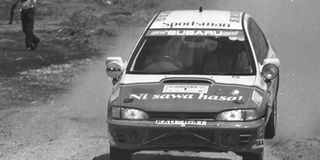Patrick Njiru made us believe in ourselves in Safari Rally

Patrick Njiru's Subaru Impreza during 1994 ARC Equator Rally.
What you need to know:
- Njiru also failed miserably after his co-driver Aslam Khan was injured.
This weekend 20 years ago, a young chap from a sleepy village in Embu made us all believe in ourselves. Patrick Njiru became the first driver to finish the Safari Rally in a Group N car, a potent showroom Subaru Legacy.
Fuji Heavy Industries had unleashed the Subaru Legacy one year earlier and all the five factory team cars came a cropper in the Safari, with Peter Possum Bourne from Australia being the highest placed Subaru driver in seventh place.
Njiru also failed miserably after his co-driver Aslam Khan was injured.
Subaru returned in the 1990 Safari in a semi-works team known as Subaru Motor Sport Group of which Njiru was a shareholder.
The car was tested and re-tested in a 10,000 kilometres sojourn under the careful eye of Noriyuki Koseki with mechanical wizard Ndoria Ikua being the only black man after Njiru in the line-up. Njiru got assistance from Dave Williamson in that epic race of 1990. Kenya was under single party rule and Robert Ouko had been murdered only two months earlier.
However, the 5,000km Safari Rally dominated that Easter weekend and the spotlight was firmly on Njiru who in 1987 finished the Safari, the first blackman since George Githu in 1979. Unlike his first Safari finish, in 1990 Njiru was commanding an armada of human resources and loads of cash to boot and true to the billing, he passed the interview with flying colours for he went on to become the Kenyan champion.
There were many suitors, led by Serena Hotels which branded the Legacy and true to his orientation as a mechanic who had studied the profession at Toyota Motor Corporation in Japan, Njiru also won the heart of Koseki who in 1991 took him to Australia WRC where he finished 18th overall.
At a time when sponsorship was an issue in rallying, Njiru was always smiling all the way to the bank with major companies like Standard Chartered Bank, SmithKline Beecham, Coca-Cola, British American Tobacco, Marlboro Cigarettes, Caltex Oil and Hilton Hotels always lining his pockets.
He repaid them in kind, his defining comment coming in 1994 when, together with Abdul Sidi, he won the Group N category and came fourth overall. This was the year for Kenyans, with Ian Duncan winning the overall title and the last by a Kenyan.
Down the line was also the emergence of Phineas Kimathi, the current CEO of the Safari Rally, Sammy Aslam, Rob Hellier, Azar Anwar, and Mark Trower for a Kenyan grand slam. Eight out of 14 finishers were home drivers.
In 1995 Njiru became the highest endorsed sportsman in Africa after signing a three-year deal with BAT at a handsome figure of 25.5 million and also used his influence to negotiate Sh108 million for the Safari for a similar period of time.
In return, he won three more Kenyan titles, raced in Malaysia and was used by the South Africa government in 1992 shortly after the end of Apartheid to promote rallying as a symbol of blackman’s tenacity to deliver results in a whites dominated event in a clear indication of the future of the rainbow nation.
But Njiru also become a victim of economic slowdown in late 90s. Always spoilt for choice with tones of equipment, Subaru Motor Sport Group ceased, giving way to the factory supported Prodrive which went on to produce the iconic Subaru Impreza. But try as they could, victory in the Safari eluded them until 1997 when the late Colin McRae, navigated by Nicky Grist, finally delivered the Safari victory.
In a way Njiru also helped promote the Impreza brand in early 90s by using the Kenya national championship series to develop the iconic brand before he unleashed it in 1994 Safari Rally under the Sportsman cigarettes livery.




